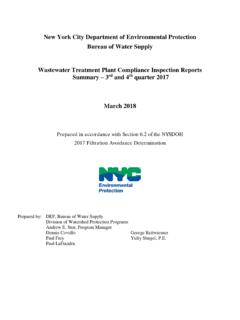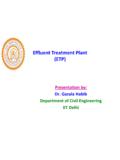Transcription of Fig 1. Flex EDR Ammonia Stack - saltworkstech.com
1 1 2018 Saltworks Technologies A municipal wastewater treatment plant contacted Saltworks looking for a reliable, fully controllable Ammonia treatment system that could meet any discharge requirements, resist high salinities and rapidly ramp on and off to meet changing capacity needs. In response, Saltworks developed Flex EDR Ammonia . Fi g 1 . Fle x EDR A m mo n ia St ack Ammonia in wastewater is a growing concern due to its detrimental impact on aquatic ecosystems. When discharged to bodies of water, Ammonia causes algal blooms that deplete dissolved oxygen and release toxins, destroying aquatic life. Regulatory agencies are increasingly requiring industries to treat Ammonia in their effluents to meet stringent requirements.
2 Some wastewater treatment plants (WWTP) are unable to comply with these regulations when their service load increases. Removing Ammonia from their 2 CASE STUDY: Removing Ammonia from wastewater treatment Plant Centrate with EDR 2018 Saltworks Technologies concentrated centrate circuit could free up as much as 20% additional Ammonia processing capacity. Many industries are also experiencing increased regulations on their wastewaters and are being cut-off from sewer discharge, in some cases due to Ammonia levels. Industrial Ammonia treatment is often more challenging for biological treatments. To treat to low Ammonia discharge limits, biological plants require expansion with large aeration tanks and clarifiers, which is challenging in areas with limited or expensive real estate.
3 Moreover, biological systems require addition of methanol and phosphorus (which act as pollutants), have little flexibility adjusting to changes in Ammonia load, and are difficult to control due to sensitivities to temperature and feed water chemistry. Biological systems are also susceptible to damage if feedstock is changed or is too saline. Other Ammonia treatment systems ( , breakpoint chlorination and air stripping) require significant quantities of chemicals and produce harmful emissions or by-products. Saltworks Flex EDR Ammonia offers an alternative to biological and chemical-intensive Ammonia treatment plants . This electrochemical treatment system leverages our next-generation IonFlux ion exchange membranes that are optimized for Ammonia removal and can selectively remove varying concentrations of Ammonia .
4 These membranes can tolerate contaminants and aggressive water chemistries while removing Ammonia to meet discharge requirements. The flexible treatment platform can either permanently destroy Ammonia to produce benign nitrogen gas, or convert it into a fertilizer by-product for reuse. The system operates without sensitivity to temperature or salinity, and unlike biological processes, does not require the addition of methanol and phosphorous that can also impact aquatic systems. The compact and modular system can either bolt onto existing plants or work independently. treatment skids can be delivered to site and the system can begin removing Ammonia in 2-3 days, compared to the months of start up time required by biological processes.
5 Through an ion exchange membrane process, Flex EDR Ammonia pulls Ammonia out from wastewaters and concentrates it into an Ammonia Capture Ionic Fluid (NH3- 3 CASE STUDY: Removing Ammonia from wastewater treatment Plant Centrate with EDR 2018 Saltworks Technologies CIF). The NH3-CIF may be treated by a Regenerator unit (Fig. 2) to convert Ammonia to nitrogen gas for destruction. The NH3-CIF can be further concentrated to form Ammonia -based fertilizers, such as ammonium sulfate, for reuse (Fig. 3). Fig 2. Ammonia Destruction with Saltworks Regenerator Fi g 3 . Pr od uct io n o f Am mo nia-Base d Fer til iz er The ammonium sulfate option is more economical due to lower energy requirements, but downstream operations will be required to handle the ammonium sulfate by-product.
6 The Flex EDR Ammonia Regenerator option can also be DC solar powered, using low cost photovoltaics to offset the energy requirements. 4 CASE STUDY: Removing Ammonia from wastewater treatment Plant Centrate with EDR 2018 Saltworks Technologies The main application for Flex EDR Ammonia is to reduce Ammonia load to free up valuable process capacity. Industrial specific applications include treating centrate, highly concentrated sidestreams in municipal WWTPs, reducing Ammonia loads in wastewaters from food and beverage, chemical production, mining, and landfill leachate. Reducing Ammonia loads in process plants can help unlock additional capacity, ultimately improving process efficiency.
7 For most municipal WWTPs, there is a highly concentrated centrate nutrient stream, accounting for roughly 1% of the plant flow but 20% of the Ammonia load, which is produced during biological sludge de-watering and is recycled back to the front end of the plant. Flex EDR Ammonia can treat the centrate as a sidestream process, reducing the Ammonia load on the WWTP, and enabling it to meet discharge limitseffectively. For industrial wastewaters such as landfill leachate, Flex EDR Ammonia advantageously resists organic foulants and is unaffected by varying salinity. Moreover, the automated self-cleaning systems maintain reliable operation. Fi g 4 . Sa ltw orks W WT P Hi gh Level P rocess F l ow Dia g ra m With experience in integrating pre- treatment , membrane, and evaporation technologies to achieve zero liquid discharge, Saltworks has the expertise to integrate Flex EDR Ammonia to help industries maximize capacity and return on investment.
8 5 CASE STUDY: Removing Ammonia from wastewater treatment Plant Centrate with EDR 2018 Saltworks Technologies Flex EDR Ammonia pilot projects were completed demonstrating reliable Ammonia load removal. Water samples from our industry partners were tested over a six-month period. The key results from the pilot projects are summarized below: 24/7 reliable operation of the Flex EDR Ammonia pilot on WWTP centrate. The plant operated for 6 months continuously (Fig 5). Ammonia mass reduction in WWTP centrate and landfill leachate: o WWTP Centrate: up to 95% reduction (1300 mg/L reduced to 64 mg/L N) (Fig. 6) o Landfill Leachate: 85% reduction (5280 mg/L reduced to 772 mg/L N) (Fig.)
9 7). Further removal of Ammonia using Flex EDR Ammonia is possible. Destruction of Ammonia to N2 gas with no substantial consumables or waste stream ( ) Production of ammonium sulfate for the fertilizer option when polishing landfill leachate evaporator crystallizer product water (Fig. 9). Fi g 5 . Re li able O per at i on o f Fle x ED R Am m on ia o n Cen tra te 6 CASE STUDY: Removing Ammonia from wastewater treatment Plant Centrate with EDR 2018 Saltworks Technologies Fi g 6 . WW TP Cen tr a te Trea t men t (Amm on ia Mass Re mo val) Fi g 7 . L and fi ll Le ach a t e Trea t men t (Amm on ia Mass Re mo val) Fi g 8 . Am m oni a i n Am mo ni a C ap tu re I onic Flui d Fu lly Des tr oyed i n the Re gene ra t or Fi g 9.
10 Am m oni u m Sul f ate Pro duc ti on Opti on . A mm on iu m Su lfa te M a x Co ncen tr at io n o f 7 . 5 % by Wei g ht Fi g 1 0 . Fle x EDR A m mo nia pil ot pl an t 7 CASE STUDY: Removing Ammonia from wastewater treatment Plant Centrate with EDR 2018 Saltworks Technologies Pilot testing on WWTP supplied and landfill leachate wastewaters confirmed the flexibility of Flex EDR Ammonia to reliably remove and destroy Ammonia from municipal and industrial wastewaters. The pilots operated without sensitivities to temperature or feed water chemistry, and can operate reliably at extremely high Ammonia levels (>5,000 mg/L). Flex EDR Ammonia can treat Ammonia at any inlet concentration and achieve up to 95% Ammonia removal from wastewater .









